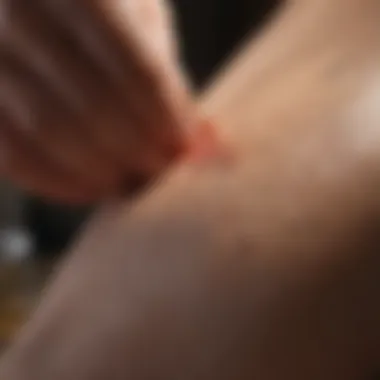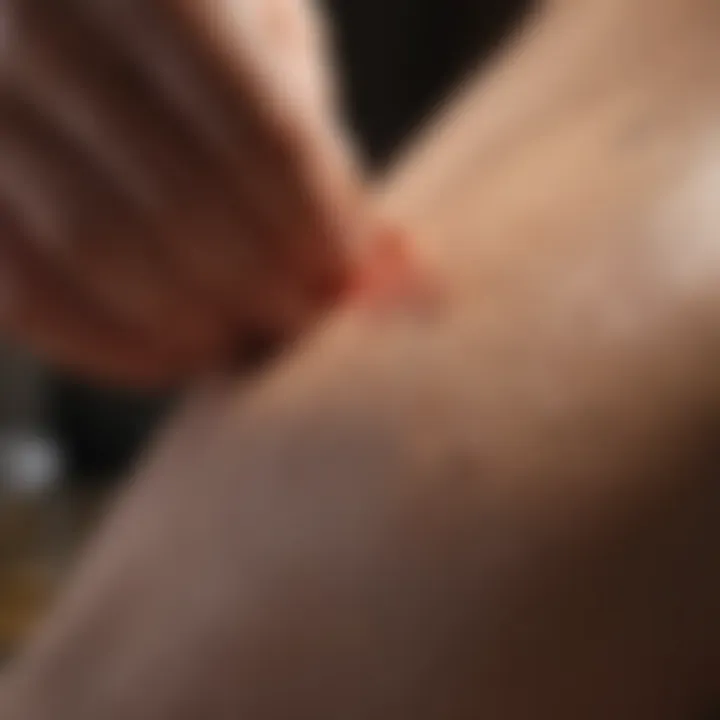Telfa Dressing: Comprehensive Wound Care Insights


Intro
Telfa dressing is a crucial tool used in various medical practice for wound care. As a non-adherent dressing, it plays an essential role in protecting the wound while promoting optimal healing conditions. Understanding Telfa dressing requires an appreciation of its composition, applications, and numerous advantages over other types of dressings. This article aims not only to detail these aspects but also to highlight the importance of proper training for healthcare providers, ensuring effective usage of the dressing in clinical situations.
Key Concepts and Terminology
Basic Definitions
Telfa dressings are sterile, non-adherent pads that can be applied to wounds. They are made of a blend of materials designed to minimize adherence to the wound bed, preventing disruption of healing tissues when the dressing is removed. The surface of a Telfa dressing typically features a plastic film that allows for fluid absorption while keeping the wound protected from contaminants.
Historical Context
The development of Telfa dressing began in the mid-20th century as demand for better wound care solutions increased. Traditional dressings would tend to stick to the wound bed, causing pain and potential setbacks in recovery. Telfa dressings were created to solve this problem, providing a gentle alternative that safeguarding healing tissue. Over the decades, medical professionals have come to rely heavily on Telfa dressings for both acute and chronic wounds in various settings.
Recent Innovations and Trends
Technological Advancements
With the ongoing development in the field of wound care, Telfa dressings are also evolving. Some newer versions incorporate advanced materials that enhance moisture balance and further reduce chances of infection. Innovations include dressings with antimicrobial properties that actively combat potential pathogens and promote healing.
Sustainable Practices
An essential trend is the move toward sustainable practices in healthcare. Manufacturers are developing Telfa dressings that consider environmental impact. Biodegradable materials are being utilized to create less waste in hospitals and medical facilities, providing effective wound management while being more eco-friendly.
Practical Applications and Techniques
Step-by-step Guides
Using Telfa dressing effectively involves several critical steps:
- Prepare the area: Ensure hands are clean by performing hand hygiene.
- Assess the wound: Determine the condition of the wound and any drainage.
- Select the appropriate size: Choose a Telfa dressing size that covers the wound without excessive overlap.
- Apply the dressing: Gently place the dressing over the wound, ensuring it does not stick to the tissue.
- Secure the dressing: Use tape or a secondary dressing to hold the Telfa in place.
Case Studies
One significant case study involved the use of Telfa dressings in a post-operative setting. Patients exhibited improved healing rates compared to those using traditional gauze dressings. Reduced pain during dressing changes enhanced patient comfort and satisfaction.
"The shift to non-adherent dressings can significantly impact the healing process and patient experience."
In another instance, a community clinic adopted biodegradable Telfa dressings with positive feedback from both staff and patients about their effectiveness and environmental benefits.
Understanding Telfa Dressing
Telfa dressing plays a vital role in modern wound care. This specific dressing is designed to protect wounds while promoting healing. Understanding Telfa dressing requires knowledge about its composition, types, and varying applications in clinical settings. Awareness of these elements enhances the effective use of Telfa dressings in practice.
Definition and Composition
Telfa dressings are non-adherent wound dressings made of a unique material. These dressings typically consist of a thin layer of gauze and a perforated film. This design helps avoid sticking to the wound while absorbing exudate. The composition allows for a safe and comfortable healing environment. Due to their non-adherent properties, Telfa dressings minimize pain during dressing changes, an important factor in patient comfort.
Types of Telfa Dressings
Various types of Telfa dressings exist to meet diverse medical needs, each designed with specific characteristics.
Sterile vs. Non-Sterile
Sterile Telfa dressings are essential in clinical settings, especially for surgical wounds. They undergo processing to eliminate bacteria, which reduces the risk of infection. The primary characteristic of sterile Telfa dressings is their packaging, ensuring a contamination-free experience. Non-sterile varieties, however, are often suitable for less critical wounds. They provide adequate support for minor cuts and abrasions but may not offer the same level of protection as their sterile counterparts. Understanding when to use each type is crucial, as sterile options significantly reduce infection risks in delicate wound scenarios.
Various Sizes and Shapes
Telfa dressings come in an array of sizes and shapes, allowing customization based on the wound type. The key aspect of this diversity is adaptability. Larger dressings might be used for surgical sites, while smaller sizes can be perfect for daily care of minor injuries. Each shape and size serves a distinct purpose, ensuring that practitioners can effectively manage wounds of varying dimensions. Choosing the right size can enhance healing efficiency and patient compliance, making this a beneficial feature of Telfa dressings.
Mechanisms of Action
The understanding of Telfa dressing's mechanisms of action is vital when discussing its applications and effectiveness in wound care. The two primary elements that characterize its action are its non-adherent properties and its ability to retain moisture. Both of these features play significant roles in how Telfa dressings support the healing process, manage pain, and reduce the risk of infection.
Non-Adherent Properties
Telfa dressings are designed to be non-adherent, which means they do not stick to the wound bed. This property is crucial as it allows for a painless removal of the dressing without disturbing new tissue that may have formed. When a traditional adhesive dressing is removed, it can cause trauma to the delicate, healing tissue. The non-adherent nature of Telfa significantly reduces this risk, promoting a more comfortable experience for the patient.
Additionally, the non-adherent surface minimizes the likelihood of debris or bacteria being trapped against the wound. By preventing these external factors from compromising the wound environment, Telfa dressings create a safer condition for healing. It is not uncommon for healthcare professionals to recommend Telfa for treatment of both acute and chronic wounds, where gentleness and protection are paramount.
Moisture Retention
Another important mechanism is moisture retention. Telfa dressings are designed to provide an optimal moist environment that is essential for effective wound healing. This controlled moisture level helps to facilitate cellular activities, such as migration and proliferation of skin cells, which are necessary steps in the healing process.
Maintaining moisture prevents the wound from drying out, which can lead to scab formation and subsequently delay healing. Telfa dressings, by retaining moisture, support a favorable environment, reducing the chances of scarring. The ability to absorb small amounts of exudate while keeping the wound environment moist is a key advantage of Telfa dressing in clinical practice.
In summary, the mechanisms of action of Telfa dressings—non-adherent properties and moisture retention—are fundamental in promoting efficient wound healing while minimizing discomfort for patients. Understanding these mechanisms allows healthcare professionals to make informed choices about wound management strategies.


Applications in Wound Care
In the realm of wound management, the application of Telfa dressing plays a crucial role in ensuring effective treatment outcomes. It is important to understand how these dressings function in various contexts, such as acute, chronic, and surgical wounds. Telfa dressings provide significant benefits while ensuring comfort for patients and ease of use for healthcare providers. With their non-adherent nature, they minimize trauma during changes and contribute to moist wound healing, which is vital for recovery.
Acute Wounds
Acute wounds, often resulting from injuries like cuts or abrasions, benefit greatly from the use of Telfa dressings. The main characteristics of an acute wound include a sudden onset and a defined healing process. When treating these wounds, Telfa dressings can absorb exudate without sticking to the wound bed, preventing disruption to newly forming tissue during dressing changes.
The primary advantage of using Telfa for acute wounds is its ability to maintain a moist environment. This moisture further promotes healing by facilitating epithelial cell migration. Additionally, Telfa dressings are available in various sizes, making them adaptable to different wound dimensions. This flexibility is crucial in ensuring optimal coverage and protection of the wound site from external contaminants.
Chronic Wounds
Chronic wounds present a more complex challenge than their acute counterparts. They are wounds that do not follow the average healing timeline, often due to underlying issues like diabetes or vascular insufficiency. In these cases, Telfa dressings are effective in managing exudate while keeping the wound bed sufficiently moist.
Utilizing Telfa for chronic wounds can help in preventing infection. The non-adherent feature of Telfa dressings reduces the risk of pain during dressing changes, a significant concern for patients with sensitive wounds. Furthermore, these dressings are conducive to granulation tissue formation, which is essential for the promotion of healing in chronic cases.
Surgical Sites
Surgical sites require particular attention due to the risk of infection and the need for optimal healing. Telfa dressings are often used in post-operative care, providing protection to incisions while allowing for necessary drainage. The barrier they create against outside contaminants plays a key role in infection prevention during the initial healing phase.
For surgical sites, the choice of dressing can influence recovery times. Telfa dressings are favored because they can remain in place longer without adhering to the wound itself. This characteristic allows for a gentle change when necessary, minimizing discomfort for the patient. Overall, employing Telfa dressings in surgical settings proves beneficial in ensuring that wounds remain optimal for healing while protecting against complications.
Benefits of Telfa Dressings
Telfa dressings offer significant advantages in wound care management. Their unique properties enhance healing, minimize discomfort, and lower the risk of infections. Understanding these benefits is crucial for healthcare professionals when making decisions about patient treatment. Utilizing Telfa dressings can lead to better outcomes and improved quality of care.
Reduced Pain and Discomfort
One of the key benefits of Telfa dressings is their ability to minimize pain and discomfort for patients. The non-adherent surface of Telfa dressings prevents the dressing from sticking to the wound. This is important during dressing changes, as it prevents trauma to the healing tissue. Patients often experience less anxiety and distress when dressing changes do not result in pain. For individuals with sensitive skin or those recovering from surgeries, this quality is especially valuable.
Healthcare providers should consider Telfa dressings when assessing wound management options for their patients. The reduced pain levels can promote better compliance with treatment, as patients are more likely to follow care protocols that are comfortable and less invasive.
Less Risk of Infection
Telfa dressings provide a barrier against external contaminants, which is vital in reducing the risk of infection. The moisture-retentive properties of these dressings help keep the wound environment stable, fostering healing while simultaneously preventing the growth of bacteria. Keeping wounds covered with Telfa dressings helps to maintain a controlled environment, lessening exposure to dirt and other pathogens that could lead to infection.
Moreover, healthcare providers can select sterile versions of Telfa dressings for surgical sites, further decreasing infection risk. Careful consideration of wound dressing choices is essential in clinical practice, especially in acute and surgical cases.
Promotes Healing
Telfa dressings contribute to the natural healing process of wounds. Their design supports a moist wound environment, which is known to facilitate faster healing rates. Proteins found in the wound exudate become concentrated under the dressing, promoting cell migration and tissue repair. This is particularly important for chronic wounds, which often face slow healing rates due to various factors such as poor blood supply or infection.
The ease of application and removal of Telfa dressings also encourages frequent monitoring of the wound's status. This allows healthcare providers to react promptly to any signs of complications, ensuring optimal healing conditions are maintained.
"The effectiveness of Telfa dressings in wound management is evident in their capacity to lessen pain, reduce infection risks, and enhance the healing process."
In sum, the benefits afforded by Telfa dressings make them an integral part of modern wound care. Their usage can lead to improved patient outcomes and satisfaction, making them a preferred choice among healthcare professionals.
Considerations for Use
Understanding the underlying principles of Telfa dressing is crucial for anyone involved in wound care management. Proper usage ensures the dressing's effectiveness while minimizing complications. This section addresses critical aspects of Telfa dressing's use, focusing on indications, contraindications, and application techniques.
Indications and Contraindications
Telfa dressings are effective for a variety of wounds due to their unique properties. Generally, they are indicated for use on:
- Superficial wounds: These include abrasions, cuts, and minor burns that do not involve deeper tissues.
- Post-surgical sites: Telfa dressings are suitable for protecting incision areas and promoting a moist healing environment.
- Chronic wounds: Their non-adherent nature makes Telfa dressings appropriate for chronic wounds like ulcers, where irritation may worsen the condition.
It is important to note contraindications as well. These may include:
- Infected wounds: If a wound is showing signs of infection, a more advanced dressing may be required.
- Heavy exudate: Telfa dressings may not be suitable for wounds that produce excessive fluid, as they can become saturated quickly.
- Allergic reactions: Healthcare providers must ensure no allergy exists to the materials used in Telfa dressings.
In essence, selecting the right indication for Telfa dressing can aid in effective wound healing, while recognizing contraindications minimizes risks.
Application Techniques
Correct application techniques play a significant role in ensuring the Telfa dressing performs effectively. Follow these essential steps:
- Prepare the wound site: Clean the wound gently with saline or a wound cleanser to remove debris and bacteria.
- Assess wound depth: Ensure the dressing covers the wound adequately without overlapping onto healthy skin unless necessary.
- Position the dressing: Place the Telfa dressing directly on the wound. If using strips, ensure they are long enough to provide coverage and secure adhesion.
- Secure the dressing: Use adhesive tape or a secondary dressing to hold the Telfa in place without disrupting the wound beneath.
- Monitor regularly: Check for signs of infection and changes in drainage, adjusting the dressing as needed.
Telfa dressings can provide an optimal healing environment when applied correctly, enhancing patient comfort and promoting faster recovery.
Overall, understanding indications and mastering application techniques ensures Telfa dressings are used effectively. These considerations promote both healing and patient well-being.
Telfa Dressing in Clinical Practice
Telfa dressing plays a significant role in clinical practice by providing effective solutions for wound management. Its non-adherent surface minimizes discomfort during dressing changes. Additionally, this characteristic helps to maintain the integrity of the healing tissue. Understanding how to incorporate Telfa dressing into day-to-day patient care is vital for healthcare providers. This knowledge not only enhances patient comfort but also supports the overall healing process.


Training Healthcare Providers
Training healthcare providers on the proper use of Telfa dressings is essential. Staff must understand the types of Telfa dressings available and their specific applications. For instance, knowing the distinction between sterile and non-sterile options allows providers to make informed choices based on individual patient needs.
Moreover, practical training on application techniques can significantly improve patient outcomes. Providers should be aware of how to apply the dressing without causing further trauma to the wound site.
The implementation of standardized protocols can reduce variability in care. Regular workshops or training sessions could reinforce the best practices in the application of Telfa dressings.
Patient Education
Patient education regarding Telfa dressings cannot be overstated. Empowering patients with knowledge about their dressings improves compliance and promotes effective healing. It is crucial that patients understand the purpose of the dressing and how to care for it.
Important points to convey to patients include:
- How to change the dressing: Clear instructions can avoid complications that arise from improper handling.
- Signs of infection: Patients should recognize indications of infection, which may necessitate immediate medical attention.
- When to seek help: Educating patients on the parameters of when to contact their healthcare provider enhances safety.
Proper patient education can reduce the incidence of complications and enhance recovery times.
Emerging Trends in Wound Care Technology
The landscape of wound care is evolving rapidly, with new technologies continually emerging to enhance patient outcomes. These innovations are critical as they improve efficiency in treatment processes and patient satisfaction. The use of Telfa dressings, a widely regarded non-adherent option, remains spotlighted within this shift. The emphasis is on advancements that not only enhance the effectiveness of these dressings but also streamline their integration into everyday clinical practice.
Innovations in Dressing Materials
Recent advancements in dressing materials have resulted in the development of more effective, multifunctional options. Innovations include new composites that incorporate antimicrobial properties into Telfa dressing designs. This reduces the risk of infection, which is a common concern in wound management.
Various manufacturers have also introduced advanced hydrocolloid variants, enabling better moisture retention while maintaining non-adhesiveness. For example, Telfa dressings infused with silver ions show promise in reducing microbial load. Such materials can significantly shorten healing times and improve the patient experience.
Furthermore, dressing materials are now developed with bioactive components. These components can actively promote healing by supporting cellular functions in the wound area. This could be vital for patients, especially those with chronic wounds, as healing might be otherwise impeded.
Integration of Digital Health in Wound Management
The integration of digital health technologies into wound management signifies a remarkable development. This encompasses the use of mobile applications, telehealth solutions, and data analytics in tracking wound healing progress. With the aid of digital tools, healthcare providers can monitor the condition of wounds remotely, allowing for more timely interventions.
Telehealth can enable consultations without the need for physical appointments. This serves as a boon for patients in rural or underserved areas, where access to specialized care may be limited. Additionally, data trackers can provide essential information on the effectiveness of a particular dressing type, including Telfa. The combination of this data can guide better clinical decisions and enhance patient outcomes.
In summary, emerging trends in wound care technology are pivotal for the future. These innovations not only aim to improve dressing materials but also embrace a holistic approach through digital health integration. This comprehensive strategy enhances the quality of care and meets the evolving needs of healthcare facilities and patients alike.
Comparative Analysis
The comparative analysis of Telfa dressings is critical in understanding their position within the broader landscape of wound care management. This section examines how Telfa dressings stack up against alternative dressing options, particularly gauze and hydrocolloid dressings. Understanding the nuances of these comparisons can illuminate the specific situations in which Telfa remains the most suitable choice. Key points of this analysis include the unique properties of Telfa, its effectiveness, and the considerations around cost and user experience. A meticulous evaluation of Telfa in relation to other dressings allows healthcare professionals to make informed decisions when treating various wound types.
Telfa vs. Other Dressings
Gauze Dressings
Gauze dressings have been a staple in wound management for many years. They are highly porous and offer good absorption of exudate from wounds. This characteristic makes them suitable for a variety of wound types, especially those with heavy drainage. However, gauze dressings can adhere to the wound bed, leading to pain and sometimes trauma during dressing changes. This is a significant drawback compared to Telfa, which boasts non-adherent properties that facilitate pain-free removal.
The key characteristic of gauze dressings is their accessibility and low cost, making them a popular choice in emergency settings. They can be easily layered and customized based on the size and depth of the wound. However, they also present challenges, such as retaining moisture and providing a protective barrier against pathogens, which Telfa does more effectively due to its unique composition.
Advantages of gauze dressings include:
- Affordability
- Availability in various sizes
- Easy to apply and remove
Disadvantages include:
- Potentially painful during removal
- Less effective in maintaining a moist healing environment
- Risk of infection due to lack of a protective barrier
Hydrocolloid Dressings
Hydrocolloid dressings represent another advanced option in wound care. They are designed to maintain a moist wound environment while providing a barrier against contaminants. This dressing type is particularly effective for wounds that require hydration to promote healing. Hydrocolloids can absorb some exudate, yet their capacity is limited compared to gauze. The key characteristic of hydrocolloid dressings is their self-adhesive properties, which limit the need for additional tape or securing methods.
While hydrocolloid dressings are beneficial due to their ability to create an ideal healing environment and provide cushioning, they can sometimes create a buildup of moisture that might lead to skin maceration around the wound. This can be a concern when used on fragile skin or in patients with specific sensitivities. In contrast, Telfa dressings do not promote excessive moisture build-up, thus managing these risks better.
Advantages of hydrocolloid dressings include:
- Moisture retention
- Easy to apply and remove
- Maintain a protective barrier
Disadvantages include:
- Risk of moisture-associated skin damage
- Limited absorption compared to gauze
- Higher cost compared to basic dressings
In summary, gauze dressings offer affordability and versatility, whereas hydrocolloids provide a moisture-retentive option. Telfa dressings, with their non-adherent features, effectively combine the benefits of both without their respective disadvantages.
Challenges in Implementation
Implementing Telfa dressings effectively in various medical settings requires understanding several challenges. Acknowledging these challenges is crucial for maximizing the benefits of Telfa dressings in wound care. It is vital for healthcare providers to address these complications to ensure proper usage and improve patient outcomes.


Supply Chain Concerns
Supply chain issues can significantly impact the availability of Telfa dressings. Inconsistent sourcing of materials or transportation disruptions may lead to stock shortages in hospitals and clinics. This brings up the question of dependency on certain manufacturers. Establishing relationships with multiple suppliers may help mitigate risks, yet, it could lead to variable quality of products.
Healthcare facilities must also consider the regional distribution of Telfa dressings. Areas with limited access may struggle to provide optimal care to patients. Understanding these supply chain dynamics is essential for ensuring consistent delivery of high-quality dressings.
One way to address supply chain concerns includes creating local partnerships with distributors. Implementing regular assessments of inventory levels can help facilities prepare for unexpected demand.
Cost-Effectiveness
Cost considerations are always a factor in healthcare implementation. Telfa dressings can be perceived as expensive compared to standard gauze dressings. Nevertheless, evaluating their cost-effectiveness is necessary. When considering overall patient care, Telfa dressings may actually save money in the long run on account of reduced infections and complications.
Investing in high-quality dressings like Telfa can minimize the need for additional treatments. This fact may lead to lower hospital readmission rates. Additionally, Telfa dressings promote faster healing, which can result in shorter patient stays and lower medical costs.
To truly assess cost-effectiveness, facilities should analyze various factors:
- Initial investment vs. long-term savings
- Time and labor associated with dressing changes
- Patient outcomes and satisfaction
Regulatory and Safety Considerations
The role of regulatory and safety considerations in the context of Telfa dressings is paramount. This segment addresses the regulations surrounding their usage, which ensures that these medical products meet necessary safety and quality standards. Compliance with established guidelines offers substantial benefits not only to healthcare providers but also to the patients receiving care.
FDA Regulations
The Food and Drug Administration (FDA) plays a critical role in overseeing the safety and efficacy of medical products, including Telfa dressings. Regulations enforced by the FDA are designed to safeguard public health by ensuring that medical devices are rigorously tested before they reach the market.
Key areas of FDA regulation include:
- Premarket Approval: Manufacturers must submit detailed documentation demonstrating the device's performance and safety.
- Labeling Requirements: Dressings must be labeled correctly, providing essential information about usage, indications, and potential risks.
- Post-Market Surveillance: Ongoing monitoring of device performance is required to address any emerging safety concerns.
These regulations are vital to maintaining confidence in medical products. They help ensure that healthcare providers can trust the performance of Telfa dressings in various applications.
Quality Control in Manufacturing
Quality control in the manufacturing of Telfa dressings is just as critical as regulatory compliance. Adhering to stringent quality standards is necessary to produce reliable and effective wound care products.
Manufacturers typically implement the following practices:
- Raw Material Inspection: Assessing all materials used in production to ensure they are free from contaminants and within specified tolerances.
- Process Validation: Systematically evaluating manufacturing processes to confirm that they produce consistent outputs.
- Final Product Testing: Conducting tests to check the performance and safety of the finished product before distribution.
Effective quality control directly impacts the dressing's efficacy in various clinical settings. It minimizes the risks of complications related to infection or improper adherence, ultimately promoting better patient outcomes.
Overall, regulatory and quality control measures ensure that Telfa dressings serve their intended purpose safely and effectively.
Future Directions
The field of wound care is ever-evolving, and Telfa dressings are no exception. Future directions focus on enhancing the efficacy, efficiency, and overall utility of these products. As medical advances continue, it is important to integrate research and development with practical applications that benefit patient care.
Research and Development Goals
Research in the area of Telfa dressings aims to address key factors that impact their effectiveness. Improving the non-adherent properties might lead to enhanced performance in various applications. Current trends indicate a substantial interest in developing materials that can better manage exudate while maintaining moisture balance.
Another critical goal is to explore biocompatibility and the potential for antimicrobial properties. There is a growing demand for products that not only protect wounds but also actively combat infection. Furthermore, continued investigation into material science can uncover new polymers or composites that serve as more effective barriers against contaminants while remaining gentle on the skin.
The introduction of smart materials is also a notable prospect. These innovative dressings would change color based on infection indicators, providing immediate feedback to healthcare providers. The integration of real-time data could transform the approach to wound management, making it more proactive.
Potential for Customization
As the healthcare landscape continues to shift towards personalized medicine, the potential for customization in Telfa dressings stands out. The ability to create dressings tailored to individual patient needs might improve healing outcomes significantly. For instance, custom sizes could reduce waste, ensuring that every dressing fits the specific wound site precisely.
Additionally, incorporating patient-specific characteristics into the dressing design could enhance comfort and efficacy. Knowing a patient’s unique skin sensitivity or healing rate allows for dressings that are more suitable for their condition. Manufacturers might explore the production of dressings with varying absorbency levels, as different wounds exhibit distinct fluid dynamics.
Furthermore, personalization could extend to aesthetics. Patients may prefer dressings that are less noticeable or match their skin tone. This aspect can play a role in psychological comfort, especially for long-term treatments. As a result, catering to diverse patient preferences will be essential in driving market acceptance.
In summary, the future of Telfa dressings involves a balance of innovative research and personalized solutions. As the healthcare industry pushes for advancements, these developments may lead to improved patient experiences and outcomes.
Culmination
The significance of the conclusion in this article lies in its summarization of the extensive information regarding Telfa dressing. The conclusion offers a crucial encapsulation of the various aspects discussed throughout the article. Telfa dressings hold an essential place in modern wound care. They offer benefits that are particularly important for healthcare professionals.
Summary of Key Points
In the previous sections, several key points were highlighted regarding Telfa dressings:
- Definition and Composition: Telfa dressings are non-adherent and promote healing while minimizing pain upon removal.
- Mechanisms of Action: Their capacity to retain moisture is vital for enhancing healing environments for the wounds.
- Applications in Wound Care: Ideal for both acute and chronic wounds, as well as surgical sites.
- Benefits in Wound Management: Includes reduced pain, lowered infection risks, and promotion of healing through non-adherent properties.
- Considerations for Use: Healthcare providers must understand the indications and proper techniques when applying Telfa dressings.
- Future Directions: Continuous research and innovation are important for expanding the uses and effectiveness of Telfa dressings in clinical settings.
Call to Action for Continued Research
It is clear from the discussions presented that ongoing research into Telfa dressings remains critical. Innovations in material science and wound care practices can lead to better outcomes in patient care.
Pursuing advanced studies in this area can not only enhance healthcare practices but also improve patients’ quality of life significantly.
Healthcare professionals, researchers, and institutions should prioritize collaborative efforts in analyzing new technologies and practices surrounding Telfa dressings. Emphasis on customization and efficacy is paramount to integrate into modern medical processes effectively.
Thus, it is essential to engage in further exploration and dialogue about Telfa dressings to capitalize on their full potential in wound management and treatment.















